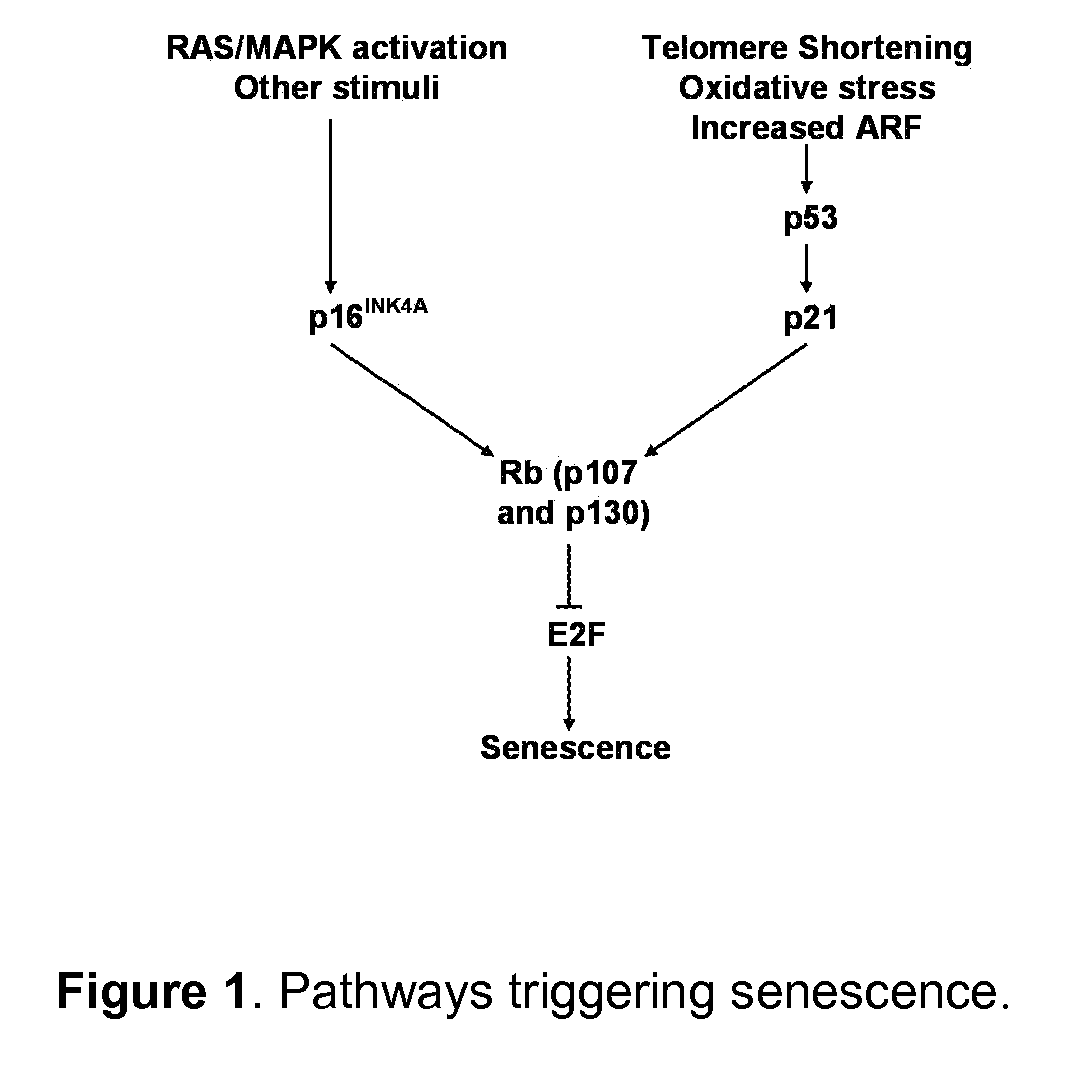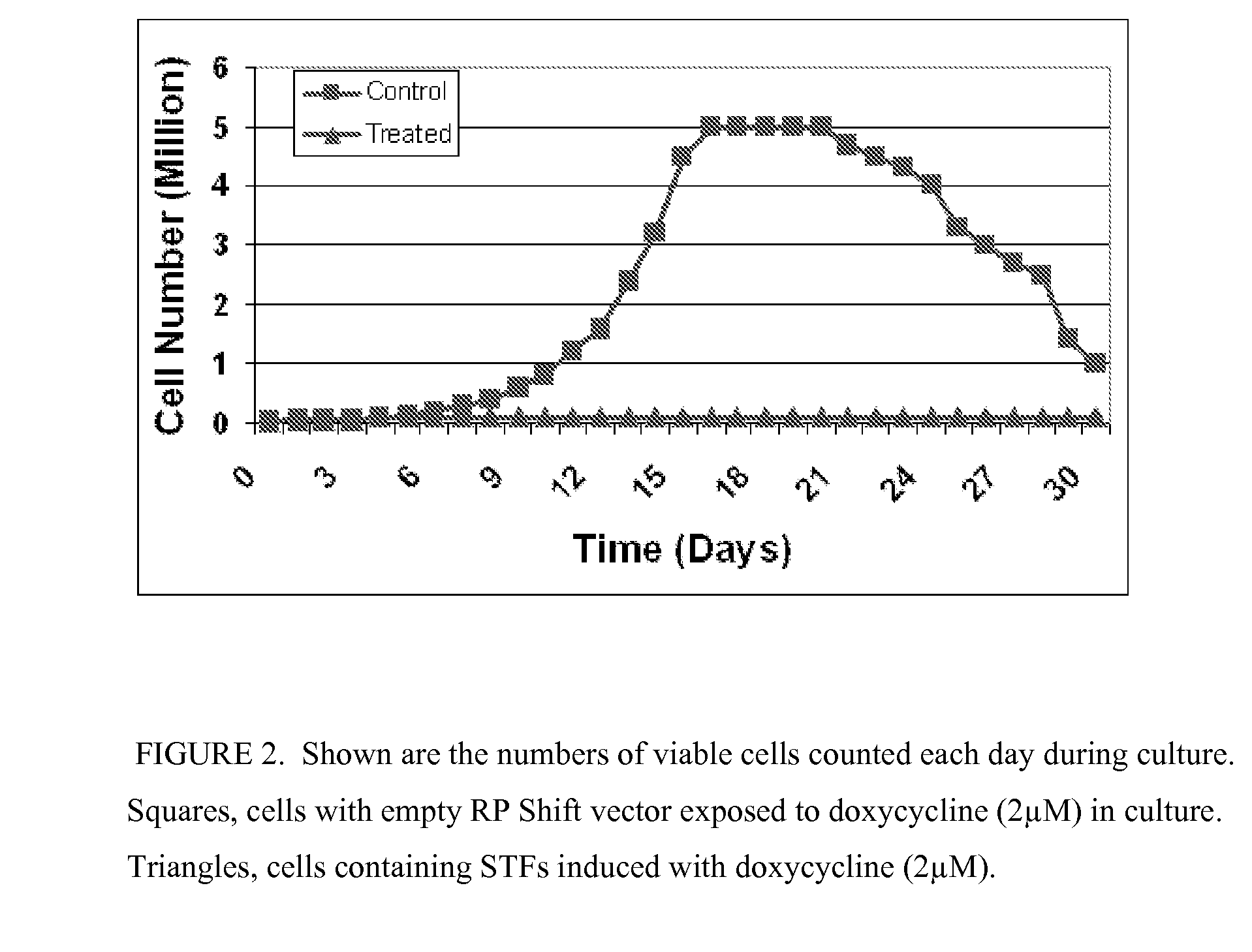Inducing Premature Senescence to Stabilize Stem Cell Feeder Layer Cells
- Summary
- Abstract
- Description
- Claims
- Application Information
AI Technical Summary
Benefits of technology
Problems solved by technology
Method used
Image
Examples
example 1
hESC Line Growth on Human Feeder Cell Layers
[0218]The hESC lines H1, H3, BG01V-Oct4-promoter-EGFP, and parent BG01V were expanded. The H1 line is a normal hESC, while BG01V-Oct4-promoter-EGFP line (available from Invitrogen, Inc., Carlsbaad, Calif.) affords a rapid promoter based method to visualize pluripotency. This line, as the normal BG01V (31), have abnormal karyotype, however as robust growing cell lines are excellent teaching and screening tool, especially when combined with red fluorescent feeder layers. (See FIG. 5). A master bank of these above mentioned cell lines was created, using standard techniques with KSR based medium (Knockout™ serum replacer, Invitrogen, Inc.) with MEFs (FIG. 5, Panels A and B) derived from CF-1 mice (obtained from WiCell, Madison, Wis.). Following cryopreservation and validation of frozen vials, the lines were adapted to human feeder layers, such as those derived from foreskin (FIG. 5, Panel C), HT420 fibrosarcoma (FIG. 5, Panels E and F), and on...
example 2
hESC Growth in RP Shift-Transformed Human Fibroblasts
[0222]hESCs were grown on human HT1080 cells transformed with the RP Shift construct as disclosed herein; FIG. 7 illustrates hES cell growth on transformed HT1080 cells. To characterize the effectiveness of RP Shift-transformed HT1080 cells to support hESC growth, one hundred thousand hESCs (H7 or BG01) were plated on Matrigel feeder layer cells of RP Shifted HT1080 cells, or irradiated human fibroblast cells. The number of colonies was counted after 4 days; results of these experiments are shown in FIG. 8. The number of H7 colonies counted for the RP Shifted cells was more than double the number of colonies observed than normal human fibroblasts. The number of BG01 colonies found in these experiments was greater than 8-fold that of normal human fibroblasts. The size of hESC colonies was also determined by microscopic inspection using a micrometer. For both H7 and BG01 hESCs, colony size was approximately 2-fold larger for cells g...
example 3
hESC Growth in RP Shift-Transformed Human Fibroblast-Derived Media
[0223]The results obtained in Example 2 suggested that soluble factor(s) secreted or otherwise produced by the RP Shifted HT1080 fibrosarcoma cells could cause the observed enhanced hESC colony and cell growth. Accordingly, hESCs were grown without feeder cells in media conditioned by RP Shift-transformed HT1080 fibrosarcoma cell growth. Media (mTeSR media) with or without addition of RP Shift-inducing amounts of IPTG was incubated with RP Shift-transformed HT1080 feeder layer cells and cultured for 2 days. The resulting conditioned media (“CmTeSR”) was added to an equal amount of fresh media (mTeSR+CmTeSR in a 50:50 ratio with IPTG) from human fibroblast cells or HT1080 fibrosarcoma cells. This mixture of conditioned medium was added to H7 cells that were grown in the absence of feeder cells (feeder free). hESC were grown under these conditions for 7 days and the number of cells in each flask was counted by trypan bl...
PUM
 Login to View More
Login to View More Abstract
Description
Claims
Application Information
 Login to View More
Login to View More - R&D
- Intellectual Property
- Life Sciences
- Materials
- Tech Scout
- Unparalleled Data Quality
- Higher Quality Content
- 60% Fewer Hallucinations
Browse by: Latest US Patents, China's latest patents, Technical Efficacy Thesaurus, Application Domain, Technology Topic, Popular Technical Reports.
© 2025 PatSnap. All rights reserved.Legal|Privacy policy|Modern Slavery Act Transparency Statement|Sitemap|About US| Contact US: help@patsnap.com



